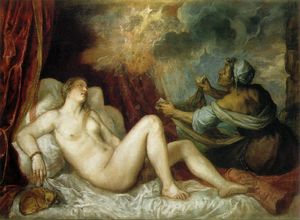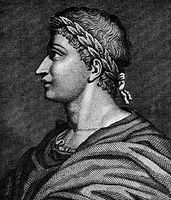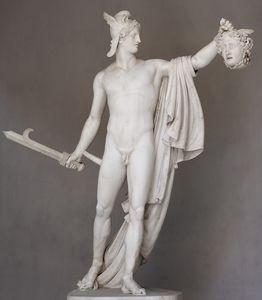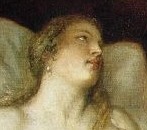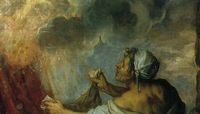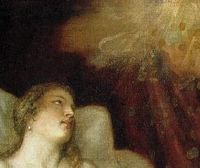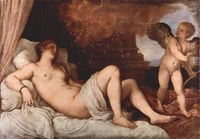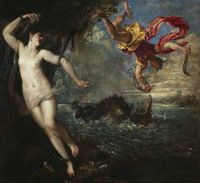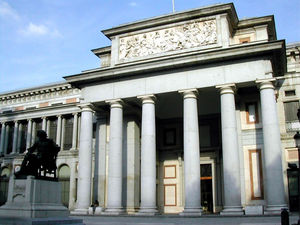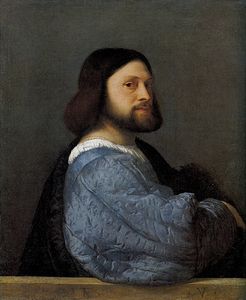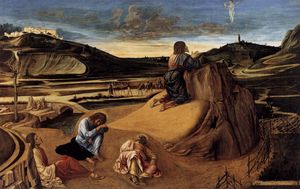Danae
- Date of Creation:
- 1554
- Alternative Names:
- Danae and the Shower of Gold, Danae and Nursemaid, Danae and the Golden Rain
- Height (cm):
- 129.80
- Length (cm):
- 181.20
- Medium:
- Oil
- Support:
- Canvas
- Subject:
- Figure
- Art Movement:
- Renaissance
- Created by:
- Titian
- Current Location:
- Madrid, Spain
- Displayed at:
- Museo Nacional del Prado
- Owner:
- Museo Nacional del Prado
Danae Story / Theme
In his 'Metamorphoses' the Roman poet Ovid briefly mentions Danae, the daughter of Acrisius, King of Argos. As was customary and expected of a ruler, Acrisius consulted an oracle - a wise or prophetic individual - prior to making important decisions. The oracle revealed to Acrisius that he would be killed by his grandson, born of the princess Danae.
Since the figures in Greek mythology often possessed the arrogant belief that they could outwit fate, Acrisius decided to lock his virginal daughter away in a tower and she was tended to only by women. Surely, if he kept her prisoner until she died a natural death, she could never become impregnated, let alone give birth to a murderous son.
In most realities, Acrisius' logic would have been infallible. Danae would have languished in the tower until her reproductive capabilities naturally dwindled and Acrisius would have been able to sleep soundly at night. But unfortunately for Acrisius, this was Ancient Greece - a place where the gods didn't know how to play fair.
Just as Danae had resolved herself to a life of loneliness and obscurity, Zeus, king of the gods, descended upon her in the form of a golden rain. Using his divine authority, Zeus used this rain to impregnate the imprisoned Danae, who gave birth to the half-human, half-god Perseus.
Aghast that his plan was foiled, Acrisius locked Danae and Perseus in a wooden chest and set them adrift in the sea, certain that they would eventually drown.
Instead, the two were protected by Poseidon, god of the sea, and landed safely on the island of Seriphos, where they were taken in by Dictys, the kindly brother of Seriphos' king, Polydectes.
By the time Perseus reached adulthood, he had gotten into the habit of protecting Danae from the numerous unwanted advances made by King Polydectes. In order to get Perseus out of the way so he could have Danae all for himself, Polydectes ordered him to bring him the head of Medusa, the Gorgon with snakes growing from her head who's gaze turned people to stone.
Perseus obliged, and using some cunning and the help of the goddess Athena, he was able to decapitate Medusa without being turned to stone.
Some versions of the myth state that after killing Medusa, Perseus traveled to Argos to claim the throne he knew was promised to him. Legend states that when he obtained an audience with his grandfather, he pulled out Medusa's head, turning him to stone and gaining the kingdom.
Another version claims that after killing Medusa, Perseus traveled to Larissa where there was a well-known sports competition taking place. He was participating in a javelin toss competition when Acrisius, who had been visiting the games as well, was accidentally pierced in the head by Perseus' javelin, thus fulfilling the prophesy.
Danae Inspirations for the Work
Commission:
This painting was commissioned by King Philip II of Spain, the son of Charles V, Holy Roman Emperor, another one of Titian's most devoted patrons. Danae was part of a series of poesie (or poesia, or poetry), as Titian christened them, depicted scenes from classical mythology.
Along with Danae, Titian completed Venus and Adonis, Diana and Acteon, The Rape of Europa, and Perseus and Andromeda, as part of Philip II's lavish, and somewhat erotic, poesie.
Phillip of Spain probably commissioned this painting and the others to both fulfill his desire for beautiful works of art as well as to live vicariously through the powerful men (who were often gods) who possessed these women.
According to Paoletti, "male patrons of such paintings imagined themselves as far superior to females [... ] The king was to imagine himself as a god, all his conquests are mere mortals."
Ovid's Metamorphoses:
Perhaps none of Titian's poesie would have been conceptualized the way they were without the help of the poet Ovid's narrative hexameter poem Metamorphoses. Written in Latin, the poem recounts the history of the world - including what is today considered mythology - from its creation until the rise of Julius Caesar. It was completed in the year 8 AD and was written in the grand oral story-telling style in which myths were usually recounted.
The tales Ovid tells in this poem are rich in heroic action but often driven by love. This overarching theme isn't surprising, considering that Ovid is also well-known for his erotic poetry, found in Heroides, Amores and Ars Amatoria.
Danae Analysis
Composition:
The scene Titian created shows nude Danaë languorously draped on a mound of pillows on her bed, attended to by an elderly and somewhat masculine nursemaid.
Zeus makes an appearance as a golden haze - which Titian and other artists have depicted more as golden coins raining down from a mysterious indoor storm cloud.
Danaë, with a peacefully sleeping puppy by her right hand, turns her head and stares vapidly (or amorously, depending on the individual perspective) at the golden rain, while her nursemaid tries vainly to intercept it before it has the chance to inseminate the girl.
Titan has framed the scene with a luscious red drape on the left and part of a stone tower on the right.
Color palette:
During his career, Titian solidified the Venetian school's preference for color and sensuality over form and draftsmanship. This is evident in Danaë in both the rich color choices and superb blending, but also in the less than perfect proportions of the figures.
Although most viewers aren't initially aware of such disproportionateness, Titian's contemporaries would have noticed.
In Danaë, Titian chose a luxuriant mixture of the primary colors - in rich crimson, saffron and azure, across the top half and the side of the painting. These are offset by the more neutral tones of the bed and Danaë's naked flesh, drawing the viewer's attention to her and her story.
Movement and energy:
The subjects of this painting - Danaë, her nursemaid and even Zeus in the form of the golden rain - each play a different role with a different level of energy. Danaë herself is totally passive and expressionless as she reclines and accepts Zeus's golden shower. Her stillness is furthered enhanced by the sleeping dog at her side.
This passivity reflects the lack of control she has over her entire life and also heightens her powerlessness - something that a great ruler like Philip might be particularly attracted to.
The nursemaid is feebly attempting to prevent the union by holding out her apron to catch the rain. She and the golden rain create a much more energetic interplay in the top part of the painting, as she reaches forward and the rain falls, partially into the apron and partially onto Danaë.
Danae Critical Reception
During life:
Michelangelo, who visited Titian's temporary workshop near the Vatican, was impressed by the artist's sound grasp of color but was disappointed by his seemingly poor grasp of the basic principals of drawing - which to many Italian artists like Michelangelo, was the pinnacle of artistic achievement. This difference of opinion didn't faze Titian, however, who continued painting in this looser, more approximate style, until his death.
Michelangelo and other artists from the Florentine school were less inclined to appreciate the freedoms Titian liked to take with figures and form, as can be seen in Danaë. The leading art critic of the time, Giorgio Vasari, stated that "it is certain, that not having studied the best work of the ancients, the Venetians know not how to mend or how to give a grace and perfection to their works beyond their model, which is never perfect in all parts."
There is no evidence, however, that the painting's owner, King Philip II of Spain, had any complaints about the quality of Titian's work.
After death:
Today's scholars and critics consider Danaë - like so many of Titian's works - to be a wonder. Citing his use of color and general creativity, scholars have praised this work even more since Vasari's anti-Venetian grip on art criticism has loosened in recent centuries.
Many subsequent artists like Rembrandt, Alexander Jacques Chantron, Gustav Klimt and Anthony van Dyck - have been influenced by Titian's Danaë and have modeled their own renditions on his original.
Danae Related Paintings
Danae Locations Through Time - Notable Sales
Danae Artist
Titian, born Tiziano Vecellio in around 1488, was a Venetian painter who is credited with developing the Venetian school of art and disseminating it throughout Europe as an alternative to the more well-known and form-conscious Florentine school.
Titian's own free-flowing, colorful style was adopted by many of his contemporaries and students, helping to solidify the Venetian style in Europe, with some even calling his style pre-Impressionist or one of the earliest examples of modern painting.
He was taught by Giovanni Bellini - the father of the Venetian school - and works such as his Danae greatly influenced later painters including Rembrandt and Rubens.
Danae Art Period
Titian painted during the Renaissance, a time of artistic flourishing conceived in Italy that rapidly spread throughout the rest of Europe. During this time, there were two competing schools of artistic thought in Italy - the Venetian and the Florentine. Venetian Renaissance art - a style pioneered by Titian - was more concerned with the emotions and senses behind the painting, as well as luscious uses of color.
Florentine art, on the other hand, valued exact form and correct draftsmanship over the sensory preferences of Venice. This ideological schism was upheld somewhat by critics such as Giorgio Vasari, who clearly preferred the Florentine school and thus gave the Venetian school less flattering reviews.
Danae Bibliography
For further reading on Titian, please choose from the following recommended sources.
• Biadene, Susanna. Titian: Prince Of Painters. Marsilio Editori, 1990
• Bowron, Edgar Peters. Titian and the Golden Age of Venetian Painting (Museum of Fine Arts, Houston). Yale University Press, 2010
• Hudson, Mark. Titian: The Last Days. Bloomsbury Publishing, 2009
• Humfrey, Peter. Titian. Phaidon Press Ltd, 2007
• Ilchman, Frederick, et al. Titian, Tintoretto, Veronese: Rivals in Renaissance Venice. Lund Humphries, 2009
• Pagden, Sylvia Ferino & Scire, Giovanna Nepi. Later Titian and the Sensuality of Painting. Marsilio,Italy, 2008

